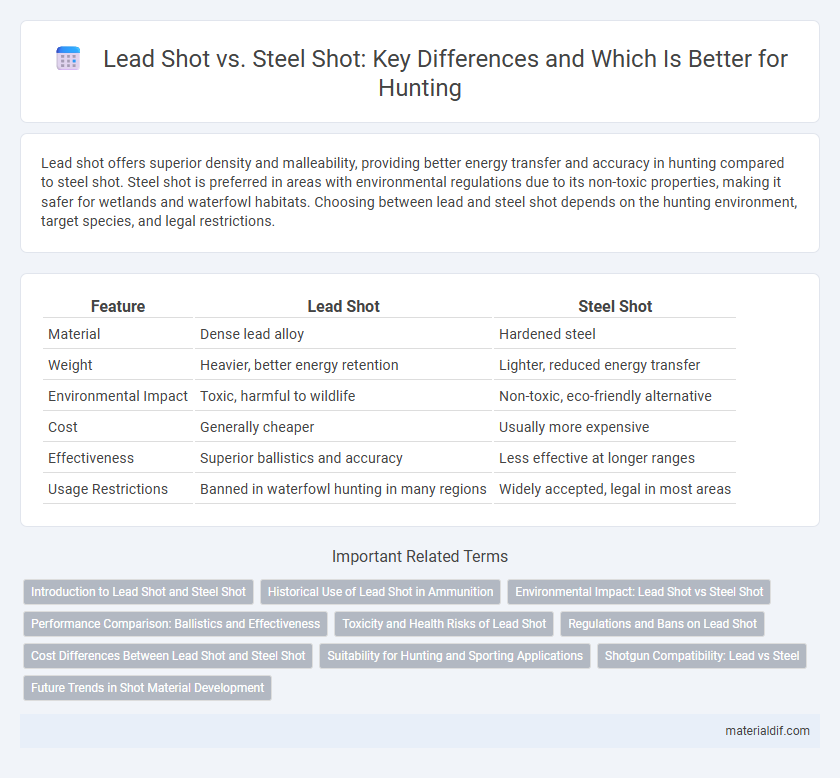Lead shot offers superior density and malleability, providing better energy transfer and accuracy in hunting compared to steel shot. Steel shot is preferred in areas with environmental regulations due to its non-toxic properties, making it safer for wetlands and waterfowl habitats. Choosing between lead and steel shot depends on the hunting environment, target species, and legal restrictions.
Table of Comparison
| Feature | Lead Shot | Steel Shot |
|---|---|---|
| Material | Dense lead alloy | Hardened steel |
| Weight | Heavier, better energy retention | Lighter, reduced energy transfer |
| Environmental Impact | Toxic, harmful to wildlife | Non-toxic, eco-friendly alternative |
| Cost | Generally cheaper | Usually more expensive |
| Effectiveness | Superior ballistics and accuracy | Less effective at longer ranges |
| Usage Restrictions | Banned in waterfowl hunting in many regions | Widely accepted, legal in most areas |
Introduction to Lead Shot and Steel Shot
Lead shot, traditionally used in shotgun ammunition, offers high density and excellent energy transfer, making it effective for hunting and shooting sports. Steel shot, a popular alternative, is lighter and non-toxic, providing an environmentally friendly option especially in wetlands where lead is prohibited. Understanding the differences in material properties and regulatory restrictions helps shooters choose the appropriate shot type for their specific needs.
Historical Use of Lead Shot in Ammunition
Lead shot has been the predominant choice in ammunition for centuries due to its high density, malleability, and ability to deliver consistent ballistic performance. Historically, lead shot was extensively used in hunting and warfare, favored for its effectiveness in penetrating targets and its relatively low cost of production. The environmental and health concerns associated with lead exposure eventually led to the development and adoption of steel shot alternatives in many regions.
Environmental Impact: Lead Shot vs Steel Shot
Lead shot poses significant environmental risks due to its toxicity, contaminating soil and water while accumulating in wildlife, especially waterfowl, leading to poisoning and population declines. Steel shot offers a safer alternative with minimal environmental impact, as it is non-toxic and biodegradable, reducing harm to ecosystems and wildlife. Regulatory measures increasingly favor steel shot to mitigate the ecological damage caused by lead contamination in hunting and shooting sports.
Performance Comparison: Ballistics and Effectiveness
Lead shot offers superior density, resulting in higher kinetic energy and better downrange performance, enhancing lethality and penetration compared to steel shot. Steel shot, though lighter and less dense, provides improved environmental safety and reduced barrel wear but often sacrifices effective range and pellet energy. Ballistically, lead maintains tighter patterns and greater velocity retention, making it preferred for long-range and larger game hunting scenarios.
Toxicity and Health Risks of Lead Shot
Lead shot poses significant toxicity risks due to its heavy metal composition, which can cause lead poisoning in wildlife and humans through ingestion or inhalation of dust particles. Steel shot is a safer alternative as it is non-toxic and does not accumulate in the environment or organisms, minimizing health hazards. Prolonged exposure to lead shot residues can result in neurological, renal, and developmental damage, making the use of steel shot preferable for environmental and public health.
Regulations and Bans on Lead Shot
Lead shot is increasingly restricted or banned in many regions due to environmental and wildlife toxicity concerns, with countries such as the United States and the European Union implementing strict regulations limiting or prohibiting its use in wetlands and hunting areas. Steel shot has become the preferred alternative in regulated zones because it is non-toxic and environmentally safer, complying with laws like the US Migratory Bird Treaty Act and the EU's Birds Directive. Hunters and manufacturers must stay informed about local and international lead shot regulations to avoid legal penalties and protect ecosystems.
Cost Differences Between Lead Shot and Steel Shot
Lead shot is generally more expensive than steel shot due to its higher density and superior ballistic performance, which makes it preferred for certain hunting applications. Steel shot offers a cost-effective alternative with lower material costs and widespread availability, appealing to budget-conscious shooters. The price difference is significant enough that many hunters opt for steel shot despite its slightly reduced lethality and increased barrel wear in some firearms.
Suitability for Hunting and Sporting Applications
Lead shot offers superior density and lethality, making it ideal for waterfowl hunting where effective range and stopping power are critical. Steel shot, being lighter and less toxic, is preferred in environments with lead restrictions, such as wetlands and migratory bird habitats. For sporting clays and trap shooting, steel shot provides cleaner performance and reduced barrel wear, enhancing longevity and compliance with environmental regulations.
Shotgun Compatibility: Lead vs Steel
Lead shot offers superior barrel compatibility in many traditional shotguns due to its softer composition, reducing wear and corrosion risks compared to harder steel shot. Steel shot requires shotguns with barrels designed or reinforced for its higher hardness and density, often necessitating modified chokes to accommodate its different ballistics. Choosing the correct shot type based on shotgun material and barrel design maximizes performance and extends firearm longevity.
Future Trends in Shot Material Development
Emerging trends in shot material development emphasize environmentally sustainable alternatives to traditional lead shot, with steel shot gaining prominence due to its non-toxic properties and regulatory acceptance. Research is advancing into novel alloys and composite materials that balance ballistic performance, environmental impact, and cost-effectiveness, addressing restrictions on lead use in hunting and shooting sports. Innovations in biodegradable and polymer-coated shot pellets promise to reduce ecological contamination while maintaining effectiveness, signaling a shift toward greener ammunition technologies in the industry.
Lead Shot vs Steel Shot Infographic

 materialdif.com
materialdif.com